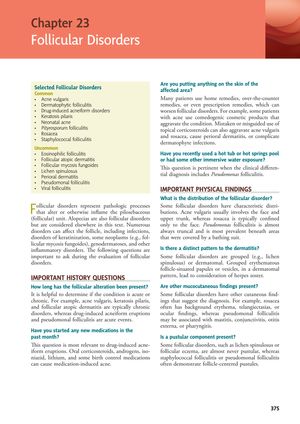Follicular Disorders: Pathogenesis, Clinical Features, Diagnosis, and Treatment
January 2018
in “
Elsevier eBooks
”

TLDR The document concludes that proper diagnosis and treatment of follicular disorders are crucial, with specific treatments for conditions like acne, drug-induced eruptions, and rosacea.
The document from 2018 provides an overview of follicular disorders, detailing their pathogenesis, clinical features, diagnosis, and treatment. It highlights the importance of history and physical examination in diagnosis. Acne vulgaris is discussed as a multifactorial disorder, with treatments ranging from topical agents to systemic isotretinoin, and a small clinical trial with 27 men indicated that washing the face twice daily may slightly benefit acne. Drug-induced acneiform eruptions, which typically resolve after discontinuing the causative drug, are also covered. Rosacea, affecting approximately 14 million Americans, is characterized by facial erythema and acneiform lesions, with treatments including intense pulsed light therapy and topical agents. Pseudomonas folliculitis, or hot tub folliculitis, is caused by Pseudomonas aeruginosa and usually resolves on its own, though severe cases may require oral ciprofloxacin. Preventive measures for this condition include proper maintenance of hot tubs and pools. Images from the Fitzsimons Army Medical Center Collection illustrate severe cases of rosacea and Pseudomonas folliculitis.





